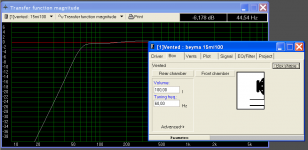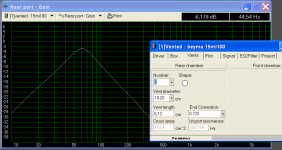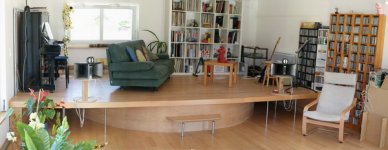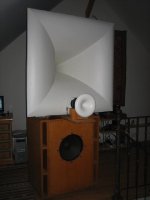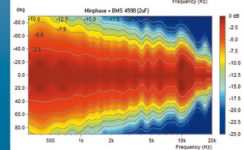Comb filtering is caused by:
poor cross over in multiway.
poor alignment.
Reflexions on a baffle
Reflections on floor wall and ceiling.
By reproducing music with a stereo system with two loudspeakers.
And where you can you shout try to reduce it is my idea. To have less interference distortion.
poor cross over in multiway.
poor alignment.
Reflexions on a baffle
Reflections on floor wall and ceiling.
By reproducing music with a stereo system with two loudspeakers.
And where you can you shout try to reduce it is my idea. To have less interference distortion.
Thanks Helmuth,
I agree there is a lot involved, I am aware of the dificulty and the experience required (that I lack), I agree I have a mindset regarding the direction to go.
Let's forget JBL for a moment.
I guess I am trying to look for advice on the details to implement a great sounding Horn speaker that has some bass "reinforcement" (because necesary for space availability) but that follows a certain school of speakers.
Like Lecleac'h, Iwata, Everest JBL, Avant garde, etc. That also can work with a very low power set (from 71a to 2a3). I bet a difficult task.
I don't feel in a position of deviating too much from mainstream schools, because this will be my second speakers project, then I feel like I have to know the standard solutions first. I bet,when you have build more speakers, have a better notion of what is what, and are much more inclined to open new paths and try different things.
I know there is people against those kind of speakers, and that there are technical reasons for it, like time alignment, or using Bass Reflex (in some cases). I also think there has to be some cualitative benchmarks, for Instance, I shouldn't build it if I am not getting better sound than with a Lowther DX4 Fidelio (that could be another option when you think in low power single ended).
Anyway, this discussion is very educative to me and I appretiate it, thanks. I am also very interested in people's point of view, and I want this post to be enjoyable for everybody, so I understand your point when you say we shouldn't be attached to a specific topology because of preconception.
OT: I've been looking your speaker designs, look like you are into more modern design (for 12W amplifier). By the way, a friend here has been working building columns with Accuton drivers. I listened to a prototype, super fast, distortion free sound using two drivers. Just sounded small because it was a monitor 89db. Now he is looking for a Mid-Twe-Mid configuration in columns where he is getting 94db. I listened those monitors with a SET 45 and it was the most detailed sound I have heard. Don't know if you have looked into those drivers or already have an opinion of those.
Best,
I agree there is a lot involved, I am aware of the dificulty and the experience required (that I lack), I agree I have a mindset regarding the direction to go.
Let's forget JBL for a moment.
I guess I am trying to look for advice on the details to implement a great sounding Horn speaker that has some bass "reinforcement" (because necesary for space availability) but that follows a certain school of speakers.
Like Lecleac'h, Iwata, Everest JBL, Avant garde, etc. That also can work with a very low power set (from 71a to 2a3). I bet a difficult task.
I don't feel in a position of deviating too much from mainstream schools, because this will be my second speakers project, then I feel like I have to know the standard solutions first. I bet,when you have build more speakers, have a better notion of what is what, and are much more inclined to open new paths and try different things.
I know there is people against those kind of speakers, and that there are technical reasons for it, like time alignment, or using Bass Reflex (in some cases). I also think there has to be some cualitative benchmarks, for Instance, I shouldn't build it if I am not getting better sound than with a Lowther DX4 Fidelio (that could be another option when you think in low power single ended).
Anyway, this discussion is very educative to me and I appretiate it, thanks. I am also very interested in people's point of view, and I want this post to be enjoyable for everybody, so I understand your point when you say we shouldn't be attached to a specific topology because of preconception.
OT: I've been looking your speaker designs, look like you are into more modern design (for 12W amplifier). By the way, a friend here has been working building columns with Accuton drivers. I listened to a prototype, super fast, distortion free sound using two drivers. Just sounded small because it was a monitor 89db. Now he is looking for a Mid-Twe-Mid configuration in columns where he is getting 94db. I listened those monitors with a SET 45 and it was the most detailed sound I have heard. Don't know if you have looked into those drivers or already have an opinion of those.
Best,
Last edited:
I have used the visaton TI100 a 4" titanium cone phaseplug basmid driver.
Very clear and bright sound. That was a high end driver.
Every driver has its own sound character, witch you can modify with smart tricks in your cross over.
I want to make a speaker a I can sell commercially that is my dream. I am now working on a 94dB 1Wmeter compact (WAF) standing 3way loudspeaker. I did buy very low distortion loudspeakers with high efficiency.
The low distortion level let you hear deeper into the details of the recording it has certainly a function to have a good driver.
The mid driver I am using for this project is a PHL-audio French made. Very high quality and normal price for such a mid driver.
Accuton I would also like to use, also I like seas magnesium cone I would like audio-technology PP. All skipped due to expensive and to low efficiency and accuton is to trendy I do not like to do the same as the rest.
As for the sound of your friends monitor with Accuton he only has to drop the midrange enough to let it sound heavier. It is about listening en correct the response to get what you like. That is real loud speaker design doing crossover changes to make the sound correct. There for you need a lot of test experience it will take lot of hours work to get that experience and feeling to do correct changes. Correction brightness and detail with wiring and capacitors. And you will invest in capacitors and drivers and end up making a lot of cost.
When it is hobby it doesn't matter, if it is to save money it will be hard to not spend to much. Often here is advised to copy a tested build like for instance troels gravensen. So a American guy email me to help him to let sound his troels DTQWT sound right. That man had read the Troels site and thought I like that sound. And was very disappointed when he had them build.
I can design a speaker that will be flat response, but can not design a speaker that sounds like some one makes up in his imagination.
You can build a high efficient loudspeaker but you can not predict that you like the sound of it.
Only if you are capable to do a lot of XO experiments you can correct a lot, if you are using good enough drivers.
Very clear and bright sound. That was a high end driver.
Every driver has its own sound character, witch you can modify with smart tricks in your cross over.
I want to make a speaker a I can sell commercially that is my dream. I am now working on a 94dB 1Wmeter compact (WAF) standing 3way loudspeaker. I did buy very low distortion loudspeakers with high efficiency.
The low distortion level let you hear deeper into the details of the recording it has certainly a function to have a good driver.
The mid driver I am using for this project is a PHL-audio French made. Very high quality and normal price for such a mid driver.
Accuton I would also like to use, also I like seas magnesium cone I would like audio-technology PP. All skipped due to expensive and to low efficiency and accuton is to trendy I do not like to do the same as the rest.
As for the sound of your friends monitor with Accuton he only has to drop the midrange enough to let it sound heavier. It is about listening en correct the response to get what you like. That is real loud speaker design doing crossover changes to make the sound correct. There for you need a lot of test experience it will take lot of hours work to get that experience and feeling to do correct changes. Correction brightness and detail with wiring and capacitors. And you will invest in capacitors and drivers and end up making a lot of cost.
When it is hobby it doesn't matter, if it is to save money it will be hard to not spend to much. Often here is advised to copy a tested build like for instance troels gravensen. So a American guy email me to help him to let sound his troels DTQWT sound right. That man had read the Troels site and thought I like that sound. And was very disappointed when he had them build.
I can design a speaker that will be flat response, but can not design a speaker that sounds like some one makes up in his imagination.
You can build a high efficient loudspeaker but you can not predict that you like the sound of it.
Only if you are capable to do a lot of XO experiments you can correct a lot, if you are using good enough drivers.
Last edited:
a nice 10" of PHL-audio.
low mid
http://www.phlaudio.com/datasheets/25_pdf/3430.pdf
mid
http://www.phlaudio.com/datasheets/25_pdf/3450.pdf
low mid
http://www.phlaudio.com/datasheets/25_pdf/3430.pdf
mid
http://www.phlaudio.com/datasheets/25_pdf/3450.pdf
Last edited:
An externally hosted image should be here but it was not working when we last tested it.
This is overall a pretty good design. (..though the placement in-room is horrible.)
It's a large Iwata flare horn (probably 250 Hz). This is quite a bit different than the Autotech "Iwata" versions with the JMLC revisions. (..less directive than the JMLC versions until the top octave to two octaves depending on the horn size and driver exit size). The super tweeter should dramatically improve on the dispersion aspect in those top two octaves (..but note the problem below).
The midbass bins are likely either 16 ohms in parallel (for the +6 db gain) with baffle step compensation, or it's a ".5" design with the bottom woofer providing baffle step compensation. Figure it's flat in-room to about 50 Hz, with not much spl below 30 Hz. IF correct, it's not a "full range" design - but rather one that needs some subwoofers. IF it extends lower in freq. then it's trading lower mid-band efficiency for lower freq. extension (..which generally is not a good compromise).
The Iwata lifted up off of the midbass bins is very good (..keeping the horn from coupling to the baffle which reduces general spaciousness and depth in particular).
The only potential problem is with driver offset when comparing acoustic center - most notably with the super tweeter (which in that regard is far to forward of the horn). (..this is NOT a problem with digital delay however.)
Last edited:
Charley because you have a omega18a why not build the conical front horn and do test how you like the sound and sensitivety and low extension. just use two amplifiers so you can correct the sensitivety to the mid high units you have.
And make plans if a sub horn is a good idea or not. It is the best way for high sensitivity.
And you can plan on the results of such a test with out making high cost.
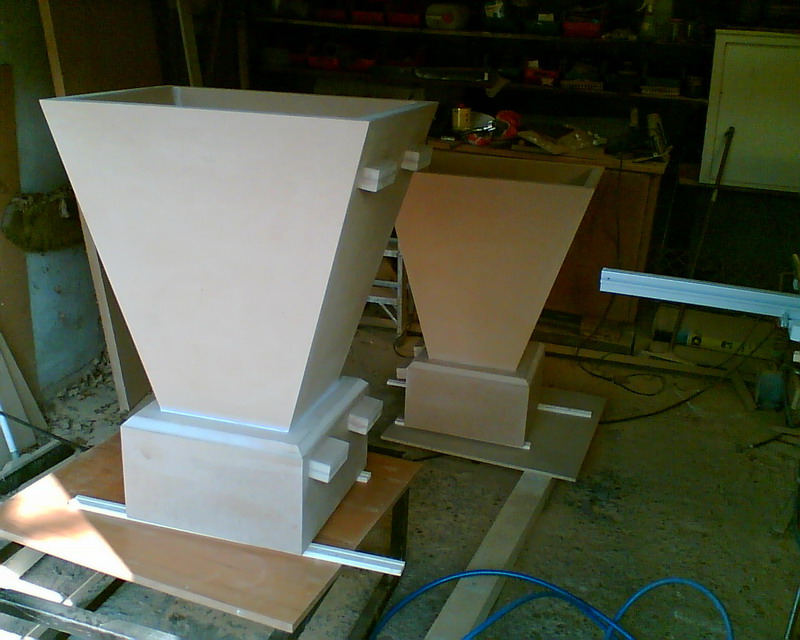
And make plans if a sub horn is a good idea or not. It is the best way for high sensitivity.
And you can plan on the results of such a test with out making high cost.

Last edited:
With the acoustic centers off, digital delay of the low drivers and the tweeter can time align output on axis at the crossover point, but can not correct for the off axis arrival time difference caused by the offset geometry.The only potential problem is with driver offset when comparing acoustic center - most notably with the super tweeter (which in that regard is far to forward of the horn). (..this is NOT a problem with digital delay however.)
The alternative, placing the tweeter and woofers back in physical time alignment with the mid driver has it's own problems of shading, reflections and diffraction.
Last edited:
Do you know the size of that front loaded horn?
Looking at the photo, hard to tell bu looks like they double the size of my current speakers. seems I wouldn't be allowed to have those babies on he living room.
For the white boxes, when you say they reach 50hz, what type of enclosure is it? Closed?
In a ported I would expect much more.
Looking at the photo, hard to tell bu looks like they double the size of my current speakers. seems I wouldn't be allowed to have those babies on he living room.
For the white boxes, when you say they reach 50hz, what type of enclosure is it? Closed?
In a ported I would expect much more.
It is the same size as the salon table, 120cm I guess. And the woofers are big to when they are 15" then it is 35cm diameter.Do you know the size of that front loaded horn?
Last edited:
Comb filtering is caused by:
poor cross over in multiway.
poor alignment.
Reflexions on a baffle
Reflections on floor wall and ceiling.
By reproducing music with a stereo system with two loudspeakers.
And where you can you shout try to reduce it is my idea. To have less interference distortion.
In principle, agreed. However, I would add that comb filtering is:
- problematic (audible and objectionable) at mid frequencies, but...
- essentially inaudible (and thus irrelevant) at very high frequencies (>5 kHz)
Marco
For a relatively small footprint with high sensitivity down to around Fb, a bass reflex is the way to go.That bass front loaded horn seems the best way to go. Not an option for me because of available space.
What is a 2nd best option for bass enclosure ?
I am reading the internet to try figure out pros and cons of Bass Reflex, Onken, Sealed, etc.
High sensitivity low cutoff <40Hz = big bas reflex box 100-250 liter
Small basreflex box <100liter and High sensitivity = high cutoff frequency >50Hz
A other option as a Basreflex would be tapped horn with small subbas speaker. Onken is also a basreflex tuning.
A very small sub is made with a ripole only efficiency will bee not so high. But the smallest you can build to have high power use two 18".
In one of the first post I did show the 15mb606 100dB 1W and cutoff about 40Hz. That is about the physical limit foor a 15" BR..
Small basreflex box <100liter and High sensitivity = high cutoff frequency >50Hz
A other option as a Basreflex would be tapped horn with small subbas speaker. Onken is also a basreflex tuning.
A very small sub is made with a ripole only efficiency will bee not so high. But the smallest you can build to have high power use two 18".
An externally hosted image should be here but it was not working when we last tested it.
In one of the first post I did show the 15mb606 100dB 1W and cutoff about 40Hz. That is about the physical limit foor a 15" BR..
Last edited:
mid-high horn + driver P audio 1" titanium.
http://www.paudiothailand.com/pdf/products/PHT-415.pdf
This also a nice one, very smooth.
http://www.eighteensound.com/index.aspx?mainMenu=view_product_simple&pid=262
http://www.paudiothailand.com/pdf/products/PHT-415.pdf
An externally hosted image should be here but it was not working when we last tested it.
This also a nice one, very smooth.
http://www.eighteensound.com/index.aspx?mainMenu=view_product_simple&pid=262
An externally hosted image should be here but it was not working when we last tested it.
Last edited:
Beyma 15MI100 (designed midrange 15") 90liter with stuffing 100dB wmtr. 5W input =107dB max
http://profesional.beyma.com/pdf/15MI100E.pdf
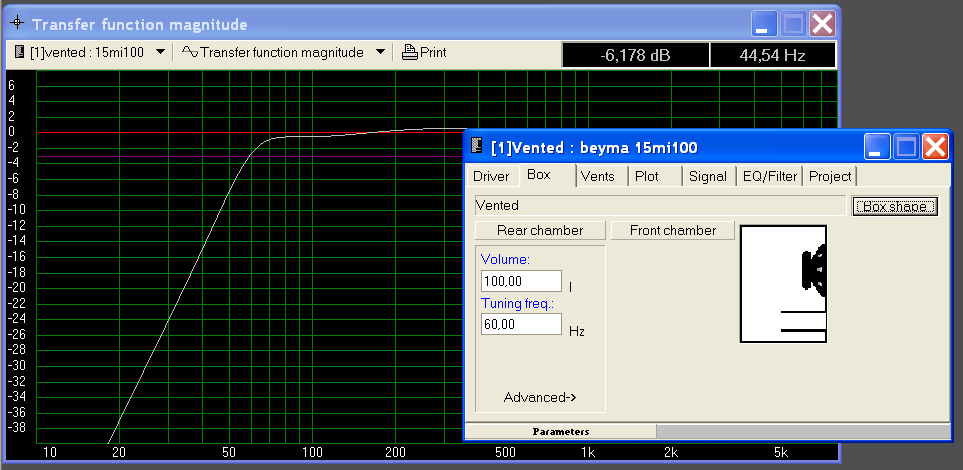
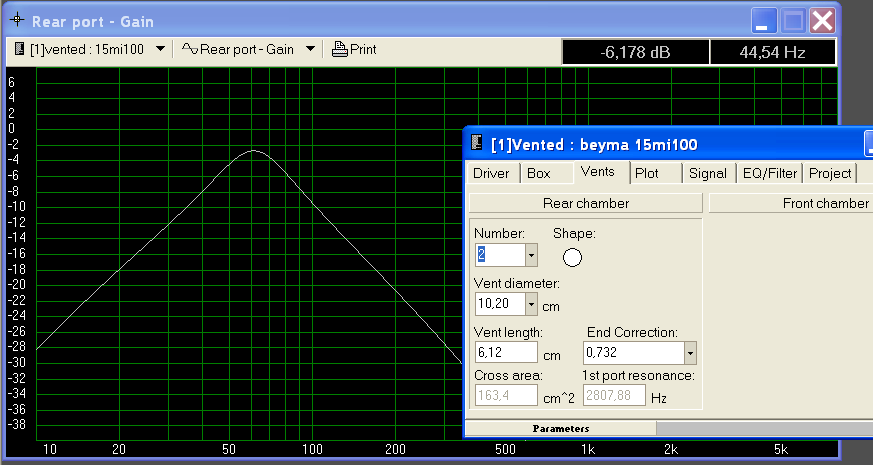
4way with itawa
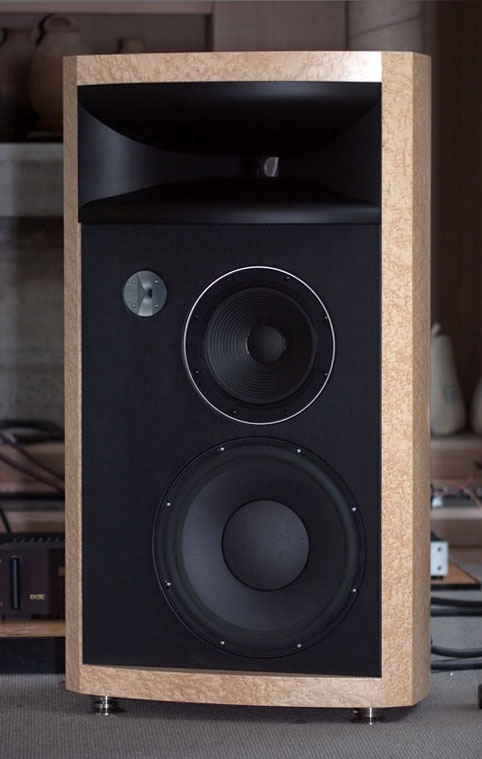
http://profesional.beyma.com/pdf/15MI100E.pdf
4way with itawa
Attachments
Last edited:
A good horn is short imo. Good dispersion with bms 4590
An externally hosted image should be here but it was not working when we last tested it.
and what do you know...this popped up searching lecleach pictures on google 
http://www.diyaudio.com/forums/multi-way/185681-my-le-cleach-horn-build-5.html
http://www.diyaudio.com/forums/multi-way/185681-my-le-cleach-horn-build-5.html
That horn driver combination has only half the dispersion at 15K as at 1K.A good horn is short imo. Good dispersion with bms 4590
If you consider that good dispersion, what does a bad dispersion look like
Attachments
- Status
- This old topic is closed. If you want to reopen this topic, contact a moderator using the "Report Post" button.
- Home
- Loudspeakers
- Multi-Way
- Design: Horn High Sensitivity Speakers
